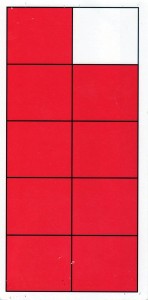Helping children develop their language skills seems much more natural than helping them learn about numbers and how they work. After all, talking, reading books, telling stories, singing, etc. all seem to blend into the day. As for math, we almost need to remind ourselves to pop in a few numbers every now and then as kids are playing and learning. Once we’ve done this a few times though it’s much easier and we find there are many natural opportunities to include numbers.
 One of the most basic concepts that children learn, first at home and then later at kindergarten, is that each number relates to a specific amount. The numbers up to 4 are fairly easy to visualize, the numbers 5 and up much harder. That’s why this is both an early kindergarten readiness and a primary grade skill. Lots of experiences are needed and here are a few ideas: counting out dishes, pasta, fruit, veggies, toys, lids, cereal pieces, and even socks. Do 9 exercises, such as 9 touch your toes, 9 jumping jacks, 9 hops on each foot, 9 side bends, and more.
One of the most basic concepts that children learn, first at home and then later at kindergarten, is that each number relates to a specific amount. The numbers up to 4 are fairly easy to visualize, the numbers 5 and up much harder. That’s why this is both an early kindergarten readiness and a primary grade skill. Lots of experiences are needed and here are a few ideas: counting out dishes, pasta, fruit, veggies, toys, lids, cereal pieces, and even socks. Do 9 exercises, such as 9 touch your toes, 9 jumping jacks, 9 hops on each foot, 9 side bends, and more.
9 is a very common number and can be spotted just about anywhere, including stores. It’s easy to draw, too. First a circle, then a line. Either going or coming today, I’m sure you and your child will see lots of 9’s. Can you take this idea to the 9’s?
